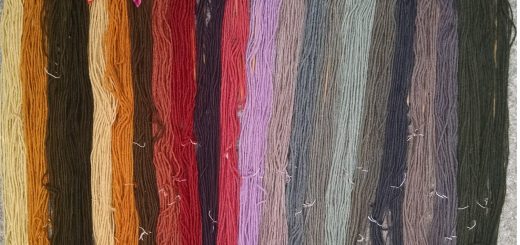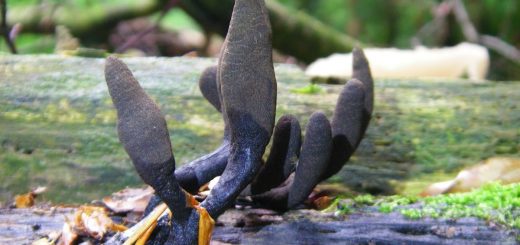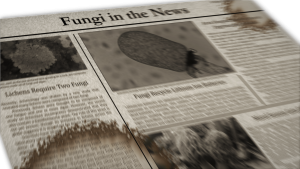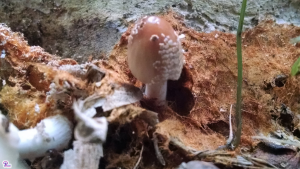#030: Mushroom Morphology: Polypores
One of the most commonly encountered mushroom morphologies is the polypore. Polypores are distinguished by a hymenium (spore-bearing surface) consisting of many, small pores. Unlike in boletes, the pore surface of the polypores cannot be easily separated from the rest of the mushroom. Polypores are a highly diverse group of mushrooms that come in a variety of shapes and sizes. The polypores you are most likely to encounter, especially during the winter, are tough to woody mushrooms that can last throughout the winter. Of these, the most common are the Turkey Tail (Trametes versicolor) and Trichaptum biforme. Both of these are medium-sized wood decomposers often found covering fallen logs or stumps. The tough fruiting bodies are annual, but can last for a year or more. Other polypores that last through the winter produce large, woody conks on the side of living trees or fallen logs. These mushrooms are perennial and get larger every year as new layers of pores are added. Some of the most common woody polypores include the Artist’s Conk (Ganoderma applanatum) and Fomes fomentarius. In the warmer seasons you can also find many fleshy polypores. These include the Chicken of the Woods (Laetiporus sulphureus), one of the easiest edible mushrooms to find and identify. Most polypores are wood decomposers, but a few fill other ecological roles. Fungi like Fomes fomentarius, Ganoderma applanatum, Grifola frondosa, and Inonotus dryadeus are parasitic to weakly parasitic on their host trees. Those in the genus Albatrellus are mycorrhizal.
So far, all of the mushrooms I have mentioned have been bracket (or shelf) fungi. Bracket fungi form horizontal fruiting bodies called conks that are attached to the substrate directly or with a short stipe. The fruiting bodies of bracket fungi often overlap and fuse. Sometimes polypores grow flat against their substrate or flat and turned up at one edge to make a small shelf. In this case, the pore surface forms on the exposed area of the mushroom. Bracket fungi may start off growing flat and later develop conks. Polypores can also form fruiting bodies with a toadstool morphology. Some fungi in the genera Polyporus and Albatrellus produce mushrooms with a pileus and central stipe. Other polypores like the Hen of the Woods (Grifola frondosa) produce large rosettes composed of smaller caps. Polypores like Inonotus dryadeus can also form brightly-colored blobs. These blobs are immature mushrooms that may not yet have pores. As the mushroom matures, pores develop on the underside of the mushroom and the upper part solidifies and becomes brown. The mature mushrooms end up looking like bracket fungi.
In addition to mushroom shape, polypores also produce a variety of pore shapes. All of the fungi mentioned above have circular pores that vary based on size of the pores and length of the tubes. In some polypores, like Polyporus alveolaris, the pores are large and close together. This can make the pores diamond-shaped or honeycombed rather than circular. Some polypores, like the aptly named Daedalea quercina, have elongated pores that result in a maze-like pore surface. The mushroom Lenzites betulina (commonly known as the “Gilled Polypore,” FFF#168) takes this even further. Its pores are completely elongated, creating gill-like structures. From above, L. betulina looks like a Turkey Tail. Combined with its tough texture, you can’t mistake this mushroom for an agaric once you pick it up. One last, interesting variation on pores is demonstrated by the Beefsteak Fungus (Fistulina hepatica FFF#165). This mushroom and other related species have separate, closely-packed pore tubes. Imagine a box of straws and you’ll have a pretty good mental image of the Beefsteak Fungus’s pore surface*.
Although most polypores are found in the Order Polyporales, a few other orders also contain polypores. Therefore, polypores form a polyphyletic group and the term “polypore” is used only in an informal sense. The orders Agaricales, Russulales and Hymenochaetales also include species with a polypore morphology. With regard to the mushrooms mentioned above, Agaricales contains Fistulina hepatica, Russulales contains the genus Albatrellus, and Hymenochaetales contains Inonotus dryadeus. All other polypores in this post are contained in the order Polyporeales. All orders that include polypores are placed within the phylum Basidiomycota.
See Further:
http://www.mushroomexpert.com/polyporales.html (for more information on the species listed above, scroll down to the links at the bottom of the page)
http://botit.botany.wisc.edu/toms_fungi/polypore.html
http://www.mushroomexpert.com/taxonomy.html
* A photo of the unique pore surface of Fistulina-like species (on right): http://www.mushroomexpert.com/pseudofistulina_radicata.html
Keep up with FFF to learn more about polypores!









![#011: Characteristics of Kingdom Fungi [Archived]](https://www.fungusfactfriday.com/wp-content/themes/hueman/assets/front/img/thumb-small-empty.png)



4 Responses
[…] characterized by a hymenium (spore-bearing surface) covered with pores. Although boletes and polypores share this characteristic, the similarities end there. In fact, they look different enough for […]
[…] nidulans is related to the core section of polypores, the Polyporales. Some older texts may refer to it as Polyporus nidulans. A more commonly […]
[…] order Agaricales. Gills also evolved in the orders Russulales, (see FFF#028), and Polyporales (see FFF#030), although these have not diversified nearly as much as the Agaricales. All these orders contain […]
[…] Polyporaceae […]